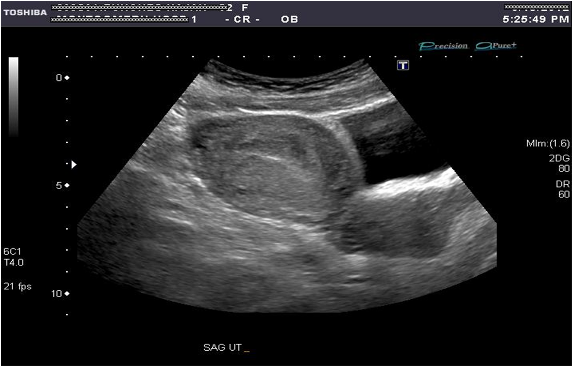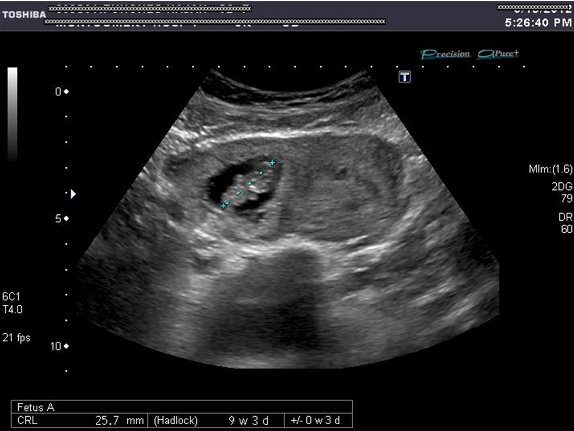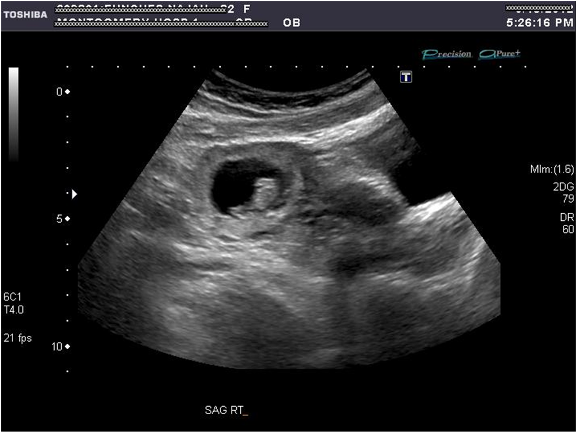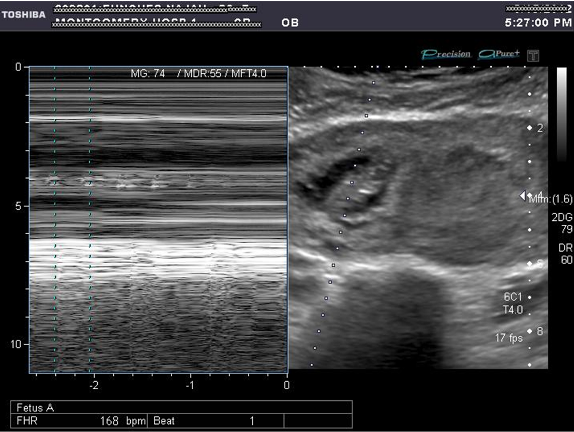Live Cornual Ectopic Pregnancy
A 32-year-old female, with previous history for ectopic pregnancy, presents to the ER with a positive pregnancy test, and right side pelvic pain. An ultrasound of the pelvis was ordered by the ER physician.
Clinical history: A 32-year-old female, with previous history for ectopic pregnancy, presents to the ER with a positive pregnancy test, and right side pelvic pain. An ultrasound of the pelvis was ordered by the ER physician.

Figure 1: Trans-abdominal image of the uterus, in the sagittal plane, demonstrates a normal appearing uterus, without evidence of an intrauterine gestational sac.

Figure 2: Trans-abdominal image demonstrates an extra-uterine gestational sac, containing an embryo with a crown rump length measuring 2.6 cm, corresponding to a mean gestational age of 9 weeks, 3 days.

Figure 3: Trans-abdominal image, in the sagittal plane, demonstrates similar finding as Figure 2. Note the gestational sac to the right of the uterine fundus.

Figure 4: Trans-vaginal image demonstrates a 9-week embryo, within a extra-uterine gestational sac.

Figure 5: Trans-vaginal image demonstrates embryonic cardiac activity, utilizing Doppler technique.
Diagnosis: Live, right-sided, cornual (interstitial type) ectopic pregnancy
Discussion: After consulting with the on-call obstetrician, the patient was taken to the operating room. At laparatomy, upon exteriorizing the uterus onto the operative field, the surgeon discovered a rounded, “golf ball” size mass, adjacent to the right uterine fundus, which was found to contain a cornual (interstitial type) ectopic pregnancy. This was proven at pathologic evaluation.
Ectopic pregnancy is one of the leading causes of pregnancy related deaths, during the first trimester. Statistics show that it occurs in up to 2 percent of all pregnancies. Major risk factors for ectopic pregnancy include previous ectopic pregnancy, PID, history of previous tubal or uterine surgery, increasing age, and usage of certain fertility drugs.
The most common site of implantation is the ampullary portion of the tube (80 percent).
Cornual or interstitial type only occurs roughly 2 percent of the time, and can be associated with life threatening maternal hemorrhage and increased morbidity. Non-tubal sites of ectopic pregnancy are a rare occurrence, with abdominal pregnancies accounting for 1.4 percent of ectopic pregnancies and ovarian and cervical sites accounting for 0.2 percent each.
Clinical presentation may include pelvic pain, vaginal bleeding, and positive pregnancy test, although these classic signs/symptoms are often not present. A high degree of clinical suspicion is necessary, especially in the setting of previous history of ectopic, and the additional risk factors, as mentioned.
The usage of medical therapy (Methotrexate) in the treatment of ectopic pregnancy can be considered if the patient is hemodynamically stable, there are no signs/symptoms of active bleeding, and the patient is reliable in terms of returning for a follow up visit.
Surgical therapy, as was indicated in this case, can be done either laparoscopically or by laparotomy. The latter was employed in this patient because of her previous surgical history and the inherent risk of adhesions, and scarring, in addition to the pre-operative ultrasound that was performed, demonstrating that this was likely to be a cornual type ectopic pregnancy. Both of these are indications for laparotomy, as opposed to laparoscopy.
Laurence J. Spitzer, MD, is associate director of the Department of Radiology at Montgomery Hospital, Norristown, Penn.
Clarius Mobile Health Unveils Anterior Knee Feature for Handheld Ultrasound
April 23rd 2025The T-Mode Anterior Knee feature reportedly offers a combination of automated segmentation and real-time conversion of grayscale ultrasound images into color-coded visuals that bolster understanding for novice ultrasound users.
The Reading Room Podcast: Current Perspectives on the Updated Appropriate Use Criteria for Brain PET
March 18th 2025In a new podcast, Satoshi Minoshima, M.D., Ph.D., and James Williams, Ph.D., share their insights on the recently updated appropriate use criteria for amyloid PET and tau PET in patients with mild cognitive impairment.
What is the Best Use of AI in CT Lung Cancer Screening?
April 18th 2025In comparison to radiologist assessment, the use of AI to pre-screen patients with low-dose CT lung cancer screening provided a 12 percent reduction in mean interpretation time with a slight increase in specificity and a slight decrease in the recall rate, according to new research.